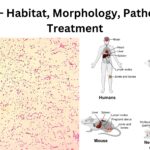IB Biology 40 Views 1 Answers
Sourav PanLv 9November 8, 2024
Describe the process of starch digestion in the small intestine and the transport of its products to the liver.
Describe the process of starch digestion in the small intestine and the transport of its products to the liver.
Please login to save the post
Please login to submit an answer.
Sourav PanLv 9May 15, 2025
The process of starch digestion in the small intestine involves several steps and enzymes, leading to the absorption of glucose and its transport to the liver. Here’s a detailed overview of this process:
1. Digestion of Starch in the Small Intestine
- Initial Digestion: Starch, a polysaccharide composed of glucose monomers, is initially broken down in the mouth by salivary amylase. However, this process is minimal since starch digestion primarily occurs in the small intestine after food has been mixed with gastric juices.
- Pancreatic Amylase: Once the chyme enters the small intestine, pancreatic amylase is secreted from the pancreas into the duodenum. This enzyme continues to break down starch into smaller carbohydrate units:
- Amylose is digested into maltose (a disaccharide).
- Amylopectin is broken down into branched chains known as dextrins .
- Brush Border Enzymes: The epithelial cells lining the small intestine possess enzymes known as brush border enzymes, which include:
- Maltase: Converts maltose into two glucose molecules.
- Isomaltase: Digests dextrins into glucose.
- Other enzymes like sucrase and lactase also contribute to carbohydrate digestion by breaking down other disaccharides.
2. Absorption of Glucose
- Transport Mechanisms: The resulting glucose molecules are absorbed through the intestinal epithelial cells via two primary mechanisms:
- Secondary Active Transport: Glucose is co-transported with sodium ions (Na⁺) using the sodium-glucose co-transporter (SGLT). This process relies on the sodium gradient established by the Na⁺/K⁺ ATPase pump.
- Facilitated Diffusion: Once inside the epithelial cells, glucose enters the bloodstream through facilitated diffusion via glucose transporters (GLUT) located on the basolateral membrane of enterocytes.
3. Transport to the Liver
- Entry into Circulation: After absorption, glucose enters the capillaries within the villi of the small intestine. From there, it travels through the mesenteric veins into the hepatic portal vein.
- Hepatic Portal System: The hepatic portal vein transports nutrient-rich blood directly to the liver. This system allows for immediate processing of absorbed nutrients before they enter systemic circulation.
4. Role of the Liver
- Glucose Regulation: In the liver, glucose can be utilized in several ways:
- It can be converted to glycogen for storage (glycogenesis) or released back into circulation to maintain blood glucose levels.
- The liver also plays a role in regulating blood sugar levels through hormonal control via insulin and glucagon.
0
0 likes
- Share on Facebook
- Share on Twitter
- Share on LinkedIn
0 found this helpful out of 0 votes
Helpful: 0%
Helpful: 0%
Was this page helpful?




